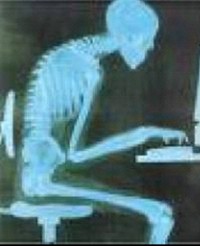Ironically, as you are reading this, I am contributing to the very condition that is the focus of this article. In fairness, the few minutes spent on this page pale in comparison to the countless hours many people spend in front of a screen daily. Whether for work, study, or leisure, prolonged screen time has led to an epidemic of musculoskeletal issues, with "computer neck" emerging as a dominant concern.
The Impact of Prolonged Computer Use
The average adult now spends several hours a day in front of a computer, with additional screen time from mobile devices exacerbating the issue. For office workers, this often extends to over eight hours per day, leading to chronic postural problems and an increase in associated pain syndromes. This forward head posture, coupled with rounded shoulders and an immobile thoracic spine, places excessive strain on the cervical and upper thoracic regions.
Understanding "Computer Neck" and Upper Cross Syndrome
The term "computer neck" is a modern name for what has long been recognized in rehabilitation medicine as Upper Cross Syndrome (UCS). This condition, first described by Czech neurologist Vladimir Janda, is characterized by a pattern of muscular imbalances: tightness in the upper trapezius and pectoral muscles, coupled with weakness in the deep neck flexors and mid-back muscles. These imbalances form a diagonal cross when viewed from the side, hence the name "Upper Cross Syndrome."
Postural Changes and Their Consequences
When these muscle imbalances persist, they lead to significant postural alterations. The shoulders round forward, the head moves into a forward-leaning position, and the thoracic spine becomes excessively kyphotic (hunched). This poor posture contributes to a range of symptoms, including:
- **Cervicogenic and migraine headaches** due to muscle tension and reduced blood flow.
- **Chronic neck pain** resulting from constant strain on the cervical vertebrae.
- **Shoulder dysfunction and rotator cuff injuries** due to abnormal positioning.
- **Thoracic Outlet Syndrome**, where nerves and blood vessels become compressed between the collarbone and first rib.
- **Mid-back stiffness and pain** caused by prolonged slouching.
Scientific Research on Screen Time and Posture
Recent studies confirm that prolonged forward head posture leads to increased cervical spine loading, contributing to early degenerative changes. Research published in the Journal of Physical Therapy Science highlights that a 15-degree forward tilt of the head increases the load on the cervical spine by approximately 12 kg, while a 45-degree tilt increases this to over 22 kg. Over time, these additional forces accelerate disc degeneration and chronic pain syndromes.
Chiropractic and Physiotherapy Approaches to Treatment
Addressing "computer neck" requires a multifaceted approach. Chiropractic care focuses on restoring proper joint mobility and reducing muscular tension, while physiotherapy emphasizes strengthening weak muscles and improving posture. Treatment typically involves:
- **Spinal adjustments** to restore mobility and realign the cervical and thoracic spine.
- **Soft tissue therapy**, including Active Release Techniques (ART) and myofascial release, to alleviate muscle tightness.
- **Targeted strengthening exercises** for the deep neck flexors and scapular stabilizers.
- **Stretching routines** to lengthen shortened pectoral and upper trapezius muscles.
Ergonomic Strategies for Prevention
For individuals unable to reduce screen time, implementing proper ergonomics is crucial. Key recommendations include:
- **Positioning the monitor at eye level** to reduce forward head tilt.
- **Maintaining a neutral spine position** by ensuring the chair supports the lower back.
- **Using an external keyboard and mouse** to avoid excessive reaching and wrist strain.
- **Taking micro-breaks every 30 minutes** to perform posture-resetting exercises.
Effective Postural Exercises
Incorporating postural correction exercises into daily routines can counteract the negative effects of prolonged sitting. Some of the most effective exercises include:
- **Chin tucks** to strengthen the deep cervical flexors and reduce forward head posture.
- **Wall angels** to activate the mid-back muscles and improve shoulder positioning.
- **Thoracic extensions** over a foam roller to combat excessive kyphosis.
- **Brugger’s Postural Relief Exercise**, a simple yet effective movement that encourages proper spinal alignment.
The Long-Term Consequences of Untreated Computer Neck
Left untreated, prolonged poor posture can lead to permanent structural changes in the spine, including disc herniation, nerve compression, and early-onset arthritis. Additionally, research has linked poor posture to decreased respiratory function, as forward head positioning reduces lung capacity. The longer these issues persist, the more difficult they become to reverse.
"Computer neck" is not just a minor inconvenience—it is a progressive condition that can lead to chronic pain, dysfunction, and long-term health consequences. Fortunately, with early intervention, proper ergonomic adjustments, and targeted rehabilitation exercises, its effects can be significantly reduced or even reversed. Seeking guidance from a chiropractor or physiotherapist can help individuals correct postural muscle imbalances and maintain long-term spinal health.













